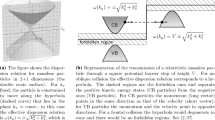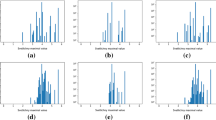Abstract
In the de Broglie–Bohm quantum theory, particles describe trajectories determined by the flux associated with their wave function. These trajectories are studied here for relativistic spin-one-half particles. Based in explicit numerical calculations for the case of a massless particle in dimension three space-time, it is shown that if the wave function is an eigenfunction of the total angular momentum, the trajectories—here called “de Broglie–Bohm cycles”—begin as circles of slowly increasing radius until a transition time at which they tend to follow straight lines. Arrival times at some detector, as well as their probability distribution are calculated, too. The chosen energy and momentum parameters are of the orders of magnitude met in graphene’s physics.







Similar content being viewed by others
Notes
See [27] for the calculation of such states in the case of the non-relativistic free particle.
This holds e.g., for a non-relativistic particle in general, or a spin 1/2 relativistic one. We do not consider here cases such as the relativistic spin zero particle described by the Klein-Gordon equation.
Its explicit form will be given below for the cases studied there.
I.e., a volume whose boundary points move along the dBB trajectories.
At least in the non-relativistic case. See footnote 1.
In fact Dirac’s original form, reduced to 3 space-time dimensions.
We restrict to positive energy contributions.
This is the so-called critical velocity, which we will denote by c.
References
Planck, M.: Ueber das Gesetz der Energieverteilung im Normalspectrum (English translation). Annalen der Physik 4, 553 (1901)
Bohr, N.: On the constitution of atoms and molecules. Philos. Mag. 26, 1–25 (1913)
Einstein, A.: Concerning an Heuristic Point of View Toward the Emission and Transformation of Light. Annalen der Physik 17, 132 (1905)
de Broglie, L.: Recherches sur la théorie des quanta, Thesis (Paris) (1924)
de Broglie, L.: Ann. Phys. (Paris) 3, 22,: Reprint in Ann. Found. Louis de Broglie 17(1992), 22 (1925)
De Broglie, L.: La mécanique ondulatoire et la structure atomique de la matière et du rayonnement. J. Phys. Radium 8, 225 (1927). https://doi.org/10.1051/jphysrad:0192700805022500
Schrödinger, E.: Quantisierung als Eigenwertproblem. Annalen der Physik 79, 361 (1926)
Schrödinger, E.: Quantisierung als Eigenwertproblem. Annalen der Physik 79, 489 (1926)
Schrödinger, E.: Quantisierung als Eigenwertproblem. Annalen der Physik 80, 437 (1926)
Schrödinger, E.: Quantisierung als Eigenwertproblem. Annalen der Physik 81, 109 (1926)
Heisenberg, W.: Über quantentheoretische Umdeutung kinematischer und mechanischer Beziehungen. Z. Phys. 33, 879 (1925)
Dirac, P.A.M.: The quantum theory of the electron. Proc. R. Soc. A 117, 610–624 (1928)
Bohr, N.: The quantum postulate and the recent development of atomic theory. Supplement to "Nature 580 (1928)
Heisenberg, W.: Physics and Philosophy. Harper, New York (1958)
Everett, H.: Relative state formulation of quantum mechanics. Rev. Mod. Phys. 29, 454 (1957)
Rovelli, C.: Relational quantum mechanics. Int. J. Theoret. Phys. 35, 1637–1678 (1996)
Di Biagio, A., Rovelli, C.: Stable facts, relative facts. Found. Phys. 51, 1–13 (2021)
Bohm, D.: A suggested interpretation of the quantum theory in terms of hidden variables. I. Phys. Rev. 85, 166 (1952)
Bohm, D., Hiley, B.J.: The Undivided Universe. Routledge, London (1995)
Bell, J.S.: Speakable and Unspeakable in Quantum Mechanics. Cambridge University Press, New York (2010)
Daumer, M., Dürr, D., Goldstei, S., Zanghi, N.: On the quantum probability flux through surfaces. J. Stat. Phys. 88, 967–977 (1997)
Das, S., Dürr, D.: Arrival time distributions of spin-1/2 particles. Nat. Sci. Rep. 9, 2242 (2019)
Das, S., Markus, N., Dürr, D.: Exotic arrival times of spin-1/2 particles I–an analytical treatment. Phys. Rev. A 99, 052124 (2019)
Holland, P.R.: The Quantum Theory of Motion, Revised ed. Cambridge University Press, Cambridge (1995)
Dürr, D., Goldstein, S., Norsen, T., Struyve, W., Zanghì, N.: Can Bohmian mechanics be made relativistic? Proc. R. Soc. A 470, 20130699 (2013)
Tumulka, R.: On Bohmian mechanics, particle creation, and relativistic space-time: Happy 100th Birthday, David Bohm! Entropy 20, 462 (2018)
Bressanini, D., Ponti, A.: Angular momentum and the two-dimensional free particle. J. Chem. Educ. 75, 916 (1998)
Wolfram Research, Inc., Mathematica, Champaign, IL
Pais, A.: On spinors in n dimensions. J. Math. Phys. 3, 1135–1139 (1962). https://doi.org/10.1063/1.1703856
Dürr, D., Goldstein, S., Zanghi, N.: Quantum equilibrium and the origin of absolute uncertainty. J. Stat. Phys. 67, 843–907 (1992)
Holland, P.R.: The Dirac equation in the de Broglie-Bohm theory of motion. Found. Phys. 22, 1287–1301 (1992)
The Wolfram Functions Site, https://functions.wolfram.com/Bessel-TypeFunctions/BesselJ/21/02/02/
WolframMathWorld, https://functions.wolfram.com/GammaBetaErf/Erf/
Katsnelson, M.I.: The Physics of Graphene, 2nd edn. Cambridge University Press, Cambridge (2020)
Sarma, S.D., Adam, S., Hwang, E.H., Rossi, E.: Electronic transport in two-dimensional graphene. Rev. Mod. Phys. 83(2), 407 (2011)
Messiah, A.: Quantum Mechanics, vol. 1, Section VIII-13, Dover Publications, New York (2014) (English translation of Mécanique Quantique, Dunod, Paris (1962))
Dürr, D., Teufel, S.: Bohmian Mechanics, Chap 16. Springer, Heidelberg (2009)
Das, S.: Relativistic electron wave packets featuring quantum backflow, arXiv:2112.13180
Leavens, C.R.: Bohm trajectory approach to timing electrons, p. 129 of Time in Quantum Mechanics—vol. 1, 2\(^{d}\). In: Muga, J.G., Sala Mayato, R., Egusquiza, Í.L. (eds.) Lecture Notes in Physics, p. 734. Springer, Heidelberg (2008)
Das, S., Nöth, M.: Times of arrival and gauge invariance. Proc. R. Soc. A 477, 20210101 (2021). https://doi.org/10.1098/rspa.2021.0101
WolframMathWorld, “Bessel function”, https://mathworld.wolfram.com/topics/BesselFunctions.html
WolframMathWorld, https://mathworld.wolfram.com/BesselFunctionZeros.html
Weisstein, E.W.: Fourier-Bessel Series. From MathWorld—A Wolfram Web Resource. https://mathworld.wolfram.com/Fourier-BesselSeries.html
Acknowledgements
I would like to thank Siddhant Das for his reading of the manuscript, the indication of interesting references and valuable comments.
Funding
No funds, grants, or other support was received.
Author information
Authors and Affiliations
Corresponding author
Ethics declarations
Conflict of interest
The authors have no financial or non-financial interests to disclose.
Additional information
Communicated by Michael Kiessling.
To my beloved Izabel.
Publisher's Note
Springer Nature remains neutral with regard to jurisdictional claims in published maps and institutional affiliations.
Appendices
Appendices
Appendix A: Notations and Conventions
Units used in this paper are adapted to the physics of graphene. Length, time and energy are given in nm, ns and meV, respectively. The critical velocity and the Planck constant take the values
Space-time coordinate are denoted by \(x^\mu \), \(\mu =0,1,2\), space coordinates by \({\textbf{x}}=(x,y)\), or \((r,{\phi })\). Space-time metric is \(\eta _{\mu \nu }\) = diag\((1,-1,-1)\)
Dirac matrices are chosen in terms of the Pauli matrices as
The Dirac matrices \(\alpha ^i=\gamma ^0\gamma ^i\) used in the non-relativistic formulation explicitly are
Appendix B: Some Useful Properties of the Bessel Functions
The general solution of the Bessel equation [41]
has the form
where \(J_n\) and \(Y_n\) are the Bessel functions of the first [41], respectively second [41] kind, and \(C_1\), \(C_2\) are two arbitrary complex constants. We shall restrict ourselves to an integer index n.
The asymptotic behaviours of the Bessel functions at the origin are given by
and at infinity by
Functions with a negative index are related to those with a positive one by the identities
Under parity \(z\rightarrow -z\), the function \(J_n\) transforms as
An interesting orthogonality property is given by [41]
for \(n\ge 0\), where \(z_{n,\alpha }\) is the \(\alpha \textrm{th}\) positive zero of the Bessel function \(J_n(z)\) [42]. Moreover, any function f(r) defined in the interval \(0\le r\le R\) with bounded variation and vanishing at the end point \(r=R\) can be represented as a “Fourier Bessel series” [43] as
for any \(n\ge 0\). The coefficients \(c_\alpha \) can be calculated using the orthogonality formula (B.7).
Rights and permissions
Springer Nature or its licensor (e.g. a society or other partner) holds exclusive rights to this article under a publishing agreement with the author(s) or other rightsholder(s); author self-archiving of the accepted manuscript version of this article is solely governed by the terms of such publishing agreement and applicable law.
About this article
Cite this article
Piguet, O. De Broglie–Bohm Cycles. Free Relativistic One-Half Particles. J Stat Phys 190, 127 (2023). https://doi.org/10.1007/s10955-023-03137-z
Received:
Accepted:
Published:
DOI: https://doi.org/10.1007/s10955-023-03137-z




